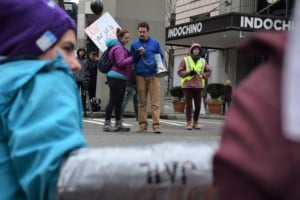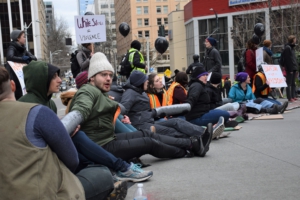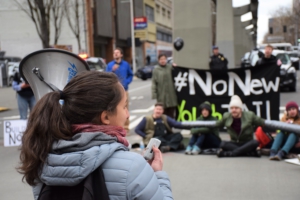
On March 2, dozens of Seattle protesters from No New Youth Jail, Ending the Prison Industrial Complex, Youth Undoing Institutional Racism and the Coalition of Anti-Racist Whites blocked the intersection in front of King County Executive Dow Constantine’s office for several hours, decrying the latter’s support of a $210 million-dollar youth jail under construction in the city.
After blocking the intersection, protesters chained themselves together with metal pipes, designed to illustrate the captive nature of numerous Seattle youth who would be the targets of the new youth and juvenile detention center being built at 12th Ave and Alder in Seattle. The prospective jail is expected to heavily target Black and Brown youth; a scenario the protesters derided as institutionalized racism.
“The institutions of prisons and policing have had racism baked in from their earliest history, shown today in the disproportionate caging of Black and Brown youth” explained Julianna Alson, an organizer with the NNYJ coalition. “Youth of color make up 10 percent of King County’s population, but more than 50 percent of youth in the current youth jail. Ample research documents lifelong physical and mental harms of incarceration and contacts with the criminal justice system – for youth and the wider community, and especially communities of color. By upholding this racial inequity, Dow Constantine’s jail – as all U.S. jails – perpetuate systemic racism.”

In addition to demanding a halt to the construction of the youth jail, the protesters urge the government and affiliated officials to stop focusing on the construction of prisons and instead invest in community-based solutions that benefit the affected youth. “Youth of color in Seattle have been leading the No New Youth Jail movement since its inception in 2012, and they have been calling for community-owned anti-racist alternatives,” noted Julianna. “This requires direct allocation of material resources and power to the communities most affected by the racist jail and criminal justice system.”
Illegal funding to incarcerate Seattle youth
In addition to the societal consequences, NNYJ protesters also drew attention to illegal funding methods currently being used to finance the jail’s construction. The youth jail, referred to officially as the “Children and Family Justice Center,” was approved in a nine-year property tax levy starting in 2012. However, EPIC sued King county and the Washington State Court of Appeals ruled in EPIC’s favor. King County was therefore only legally permitted to levy taxes for the first year following the ballot initiative, generating approximately $20 million dollars of the $210 million-dollar project budget.

King County challenged the ruling, and the Washington State Supreme Court has not yet ruled whether it will consider the County’s appeal. In the meantime however, King County chose to continue with the use of tax payers’ money to finance the jail’s construction, regardless of the tax levy limitations. Should the State Supreme Court decide not to hear the case or uphold the Court of Appeals’ ruling, the County will suddenly be left needing over $100 million from another source; a shortfall which many suspect will be drawn directly from the County’s General Fund, which provides critical funding for health and human services programs.
Disrupting ‘business as usual’
The protest later moved to the Westin Hotel for several hours; a site chosen due to a fundraiser taking place inside being attended by state and local representatives, who were loudly criticized by the protesters for ignoring the youth jail and failing to support the needs of youth of color in their communities. At one point, several protesters infiltrated the fundraiser and managed to get access to the microphone long enough address the attendees on the issue of the youth jail before security arrived.
The disruptive nature of the action, as well as the chained protesters, drew massive media attention to the issue, prompting widespread discussion and debate on the costly youth jail and the movement to end it. It also forced significant pressure on Dow Constantine, who was originally scheduled to attend the fundraiser but suspiciously failed to appear. Julianna however was hardly surprised. “Dow says he is willing to work with us, but he has become increasingly evasive – hiding his schedule, skipping speaking events, and refusing to meet in public. We blocked traffic to make sure Dow can’t dodge responsibility for continuing to build a racist jail.”
As a whole, the protesters involved considered the action to be highly successful. “We know that the youth jail is a manifestation of intersecting systems of oppression,” noted Julianna. “By strengthening the NNYJ movement and supporting the liberation of people affected by each of these systems, we build a network (a “net that works”) to strengthen all of our struggles.”





